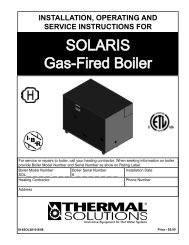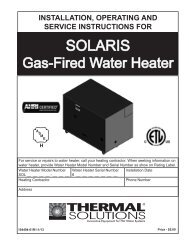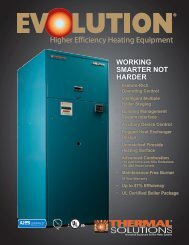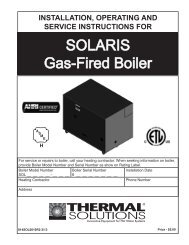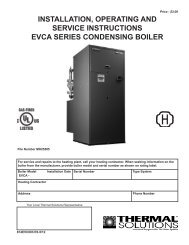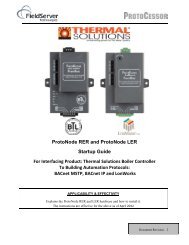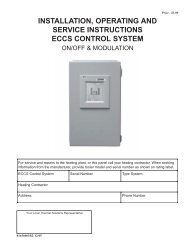installation, operating and service instructions eva series boiler
installation, operating and service instructions eva series boiler
installation, operating and service instructions eva series boiler
Create successful ePaper yourself
Turn your PDF publications into a flip-book with our unique Google optimized e-Paper software.
III. Installation<br />
A. VENTING<br />
1. General Guidelines<br />
a. The vent system must be in accordance with the<br />
National Fuel Gas Code/NFPA 54 ANSI Z222.3,<br />
Part 7, Venting of Equipment or Applicable<br />
provisions of Local Building Codes.<br />
b. All vent pipe must be adequately supported with<br />
vent supports no less than five (5) feet apart. The<br />
completed vent system must be rigid <strong>and</strong> able to<br />
withst<strong>and</strong> impacts without collapse.<br />
c. This <strong>boiler</strong> requires AL29-4C ® venting. Boiler<br />
is certified for use of single wall AL29-4C ®<br />
venting. Consult factory for any other venting<br />
materials.<br />
WARNING<br />
Do not use this <strong>boiler</strong> with galvanized<br />
based vent systems.<br />
d. This <strong>boiler</strong> may be operated with conventional,<br />
sidewall or vertical venting. Conventional<br />
vented appliances operate with negative pressure<br />
in the vent pipe. Sidewall <strong>and</strong> vertically vented<br />
<strong>boiler</strong>s operate with positive pressure in the vent<br />
pipe. Positive pressure vent pipe can be mated to<br />
the <strong>boiler</strong> without any adapters.<br />
e. Consult vent pipe manufacturer's <strong>instructions</strong> for<br />
minimum clearance to combustible material for<br />
vent components. In the absence of <strong>instructions</strong>,<br />
the minimum clearance to combustible material<br />
is six (6) inches.<br />
f. Consult vent pipe manufacturer's <strong>instructions</strong><br />
for proper method of sealing vent pipe sections<br />
<strong>and</strong> fittings. In the absence of <strong>instructions</strong>, make<br />
sure pipe <strong>and</strong> fittings are clean by swabbing with<br />
alcohol. Use Dow Corning 736 or 732 RTV,<br />
Polybar #500 RTV or Sil-bond 4500 or 6500 to<br />
seal vent pipe. Do not use other adhesives or<br />
sealants except as expressly permitted by the<br />
vent pipe manufacturer's <strong>instructions</strong>.<br />
g. Refer to the appropriate drawings in this<br />
section of this manual to determine the proper<br />
configuration of venting system.<br />
h. Consult vent pipe manufacturer's <strong>instructions</strong><br />
for vent system assembly. Follow vent pipe<br />
manufacturer's <strong>instructions</strong> if those <strong>instructions</strong><br />
conflict with this section.<br />
i. Install vent system before installing air intake,<br />
water, gas or electrical connections.<br />
2. IMPORTANT<br />
WARNING<br />
DO NOT USE vent dampers with this <strong>boiler</strong><br />
unless authorized by factory.<br />
The Commonwealth of Massachusetts requires<br />
compliance with regulation 248 CMR 4.00 <strong>and</strong> 5.00<br />
for <strong>installation</strong> of side-wall vented gas appliances as<br />
follows:<br />
(a) For all side wall horizontally vented gas fueled<br />
equipment installed in every dwelling, building or<br />
structure used in whole or in part for residential<br />
purposes, including those owned or operated by the<br />
Commonwealth <strong>and</strong> where the side wall exhaust<br />
vent termination is less than seven (7) feet above<br />
finished grade in the area of the venting, including<br />
but not limited to decks <strong>and</strong> porches, the following<br />
requirements shall be satisfied:<br />
INSTALLATION OF CARBON MONOXIDE<br />
DETECTORS. At the time of <strong>installation</strong> of the<br />
side wall horizontal vented gas fueled equipment,<br />
the installing plumber or gas fitter shall observe<br />
that a hard wired carbon monoxide detector with an<br />
alarm <strong>and</strong> battery back-up is installed on the floor<br />
level where the gas equipment is to be installed. In<br />
addition, the installing plumber or gas fitter shall<br />
observe that a battery operated or hard wired carbon<br />
monoxide detector with an alarm is installed on each<br />
additional level of the dwelling, building or structure<br />
served by the side wall horizontal vented gas fueled<br />
equipment. It shall be the responsibility of the<br />
property owner to secure the <strong>service</strong>s of qualified<br />
licensed professionals for the <strong>installation</strong> of hard<br />
wired carbon monoxide detectors.<br />
In the event that the side wall horizontally vented<br />
gas fueled equipment is installed in a crawl space or<br />
an attic, the hard wired carbon monoxide detector<br />
with alarm <strong>and</strong> battery back-up may be installed on<br />
the next adjacent floor level.<br />
In the event that the requirements of this subdivision<br />
can not be met at the time of completion of<br />
<strong>installation</strong>, the owner shall have a period of thirty<br />
(30) days to comply with the above requirements;<br />
provided, however, that during said thirty (30) day<br />
period, a battery operated carbon monoxide detector<br />
with an alarm shall be installed.<br />
APPROVED CARBON MONOXIDE<br />
DETECTORS. Each carbon monoxide detector as<br />
required in accordance with the above provisions<br />
shall comply with NFPA 720 <strong>and</strong> be ANSI/UL 2034<br />
listed <strong>and</strong> IAS certified.<br />
SIGNAGE. A metal or plastic identification plate<br />
shall be permanently mounted to the exterior of the



